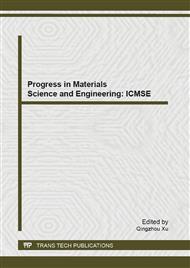[1]
I. Mejía, A. Bedolla-Jacuinde, C. Maldonado, J.M. Cabrera., Hot ductility behavior of a low carbon advanced high strength steel (AHSS) microalloyed with boron, J. Mater. Sci. Eng. A., 528 (2011) 4468-4474.
DOI: 10.1016/j.msea.2011.02.040
Google Scholar
[2]
Kyung Chul Cho, Dong Jun Mun, Yang Mo Koo, Jae Sang Lee, Effect of niobium and titanium addition on the hot ductility of boron containing steel, J. Mater. Sci. Eng. A., 528 (2011) 3556-3561.
DOI: 10.1016/j.msea.2011.01.097
Google Scholar
[3]
G.W. Fan, J. Liu, P.D. Han, G.J. Qiao, Hot ductility and microstructure in casted 2205 duplex stainless steels, J. Mater. Sci. Eng. A., 515 (2009) 108-112.
DOI: 10.1016/j.msea.2009.02.022
Google Scholar
[4]
Y.H. Sun, Y.J. Ni, Z.B. Xu, and K.K. Cai, Mechanical and metallurgy behaviour of medium carbon steel, J. Journal of University of Science and Technology Beijing(in Chinese), 31 (2009) 708-713.
Google Scholar
[5]
W.M. Zen, Study of Rolling Process with Physic Simulation on Ultra-High Strength low-alloy complex phase Steels, D. master thesis, Shanghai University, (2011).
Google Scholar
[6]
B. Mintz, R. Abu Shosha, Influence of Vanadium on Hot Ductility of Steel, J. Ironmaking and Steelmaking. 20 (1993) 445-452.
Google Scholar
[7]
Y.J. Zhang, J.T. Han, J.Q. Kong, ect., Research on High Temperature Ductility of ER70S-6 Continuous Cast Slabs, J. Metal Materials and Metallurgy Engineering, 37 (2009) 3-6.
Google Scholar
[8]
Y.M. Won, K.H. Kim, T.J. Yeo, Effect of cooling rate on ZST, LIT and ZDT of carbon steel near melting point, J. ISIJ International, 38 (1998) 1093-1099.
DOI: 10.2355/isijinternational.38.1093
Google Scholar
[9]
Y. Ohmori,Y. Maehara., Precipitation of NbC and hot ductility of austenite stainless Steels, J. Trans. Jpn. Inst. Met., 25 (1984) 160-167.
DOI: 10.2320/matertrans1960.25.160
Google Scholar
[10]
H.L. Yu, Y.X. Wang, J. Zhang, S.X. Yang, X.H. Liu, Review on factors of surface cracks in slab and their behavior during rolling, J. Forging & Stamping Technology (in Chinese), 35 (2010)1-5.
Google Scholar
[11]
C.H. Shi, S.P. Xiao, L.T. Xiang, The research of production process about domestic Atmospheric corrosion Resistant Steel, J. Chongqing steel Co. Technology (in Chinese), 55 (2012) 28-40.
Google Scholar
[12]
M. Lutz, X.H. Xu translator, Titanium as a reinforcement element and control of sulphide elements in low carbon steel, J. Baosteel intelligence (in Chinese), 1989, supplement: 149-158.
Google Scholar


